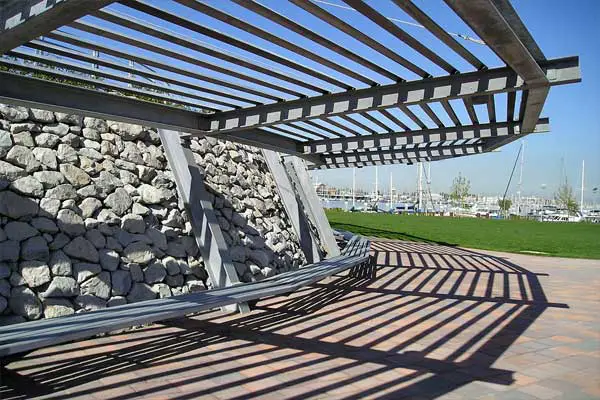Last Updated:June 22, 2025
Do cooling fans work?

Misting fans are a modern solution to an old problem. They spray tiny droplets of water into the air that evaporate. The evaporation takes heat from the air, and the cooler air is then blown around by the fan. Misting fans may not be as efficient at cooling down your home or workplace as other solutions like A/C units and window-mounted units, but misting fans can be used outside on a patio or deck area where an A/C unit wouldn’t be practical.
This guide we’ll cover how misting fans work, and why you may want to add one to your patio.
How do misting fans work
Misting fans work by spraying tiny water droplets into the air. These water droplets have a high surface area and the warm air will cause them to evaporate. The rate at which they evaporate will be determined by three factors:
- Size of Water Droplet
- Outside Temperature
- Humidity
A professional misting fan can lower the air on a patio or sidewalk by as much as 30 degrees on a hot Arizona summer day.
How does water droplet size affect the cooling from misting fans?
When water is sprayed out of the mister the size of the droplet will be determined by the size of the nozzle and the pressure in the system. A standard garden hose will have a flow of 40 Pounds per square inch(PSI), but it can get as high as 80 PSI.
Residential misting systems will have a 120 PSI. They can get there with the same amount of pressure as a standard garden hose, but by forcing the water out of a smaller opening.
Think about it like the sprayer on your garden hose. When the valve is fully open, it will just pour out in a solid stream that doesn’t travel very far. As the hole gets smaller and smaller the same amount of water is going through the hose, yet it is simply traveling further.
Misting fans work by having tiny holes that are the size of pin pricks that the water is forced through.
There are two reasons that you want the smallest possible droplet size.
Big droplets get people wet – If you are standing next to a leaky spigot for any amount time, you will eventually get wet. This is because the surface tension will hold the water molecules together until it gets large enough to fall. At which time, there won’t be enough exposed surface area for the drop to evaporate before it hits the ground or whoever is unlucky enough to stand under it.
By having tiny water drops that are propelled from the hose, you are not allowing them to form into bigger clusters.
Smaller droplets faster – Pardon, a quick physics lesson, but the third law of thermodynamics states that temperature flows from hot to cold. This means that the air molecules that surround the water droplets will look to even out the temperature.
The water more surface area between the air and the water, the faster this absorption will occur. If you want to try an experiment, you can get fill a gallon bucket with water and freeze it. Also, get 16 eight ounce plastic cups that you can fill with water and freeze.
Once both are fully frozen remove them from their containers and sit them outside on a warm day.
All the small cups will melt long before much of the large gallon ice has even changed shape.
The reason is that the air around each cup size ice block is having it’s heat pulled out of the air which causes the small ice blocks to melt. Conversely, the middle of the large ice block is being insulated by the outer portion of the ice.
You may be surprised that the temperature really won’t matter as long as it’s above freezing. The smaller ice blocks will always melt much faster than the larger ice blocks.
Manufacturers of misters and misting fans understand this so they make the water droplets as small as they can safely make them to get the evaporation time as close to zero as possible.
How does outside temperature affect the cooling from misting fans?
Simply put, there is a direct correlation between the air temperature and the rate the water will evaporate. Temperatures over 110 will lead to small water droplets evaporating in under a second.
If the temperature is in the 80s, misting fans loose so much of their cooling ability they normally aren’t even used. It will take multiple seconds for the water droplets to fully evaporate which will lead to people around them getting wet.
If you want to try a home experiment, you can take two equally sized ice cubes. Place one in a cup of warm water and the other in a cup of the same size with cold water.
Just like the previous experiment, the ice will melt at considerably different rates. The warmer water will always melt faster, and the time difference will be determined by how much hotter the warm water is over the cold water.
How does humidity affect the cooling from misting fans?
Humidity is a measurement of how much water is already in the air. If there is a 100% humidity in the air, misters and misting fans will have very little impact. The reason is that the air is holding as much moisture as it can.
While the third law of thermodynamics wants the warmer air molecules to shed its heat to the cooler water droplets, there is simply no space in the air for them to go and therefore the heat transfer won’t happen.
Conversely in areas of near 0 humidity, the heat transfer will happen more quickly. This is what makes Arizona such a stellar place for misting fans. We frequently have summer days of very little humidity meaning that misters can be run for long periods of time before the air gets saturated.
Why use misting fans over misters?
As a home owner who just wants a misting system for your patio, a simple mister can be a great solution. If you are going to run it for a couple hours to cool off your patio you will still see benefits.
Misting fans have several advantages though that allow them to work for longer periods of time.
Misting fans move air around. As water evaporates in an area, the humidity will increase. By having a fan circulate the air, there is always fresh warmer air to soak up the water moisture from the water droplets.
Misting fans blow the water droplets in random directions which spread them out further. This is different than just having pressure that will push the droplets out straight from the nozzle. The fan will push the droplet along one plane while the nozzles push it against another. This will result in a wider spread along three dimensions.
Misting fans also can cause a wind chill effect of blowing air over the skin of people near the fan. This results in the people near the fan feeling cooler even beyond what the actual thermometer would say.
Misting Fans vs Air Conditioners–Which Is Better?
It’s not fair to compare misting fans to air conditioners. They are used in different areas. This question is like asking which is better a snow mobile or a jet ski. The answer to that question depends entirely where you are. I’d prefer the snow mobile in Alaska and the jet ski in Hawaii.
To cool indoor spaces, my top choice is an air conditioner. To cool outdoor spaces, my top pick is a misting fan.
Wrapping up
That’s our guide for misting fans. We hope we haven’t bored you with the science behind them and how they work. We love looking at DIY project from the lens of middle school science class. If you have a misting fan, we’d love to hear from you.




